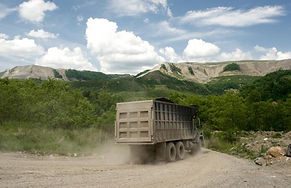Threats to the ecosystem
Mining and deforestation
The U.S. Environmental Protection Agency estimates that by 2012, mountaintop removal had destroyed 1.4 million acres of Appalachian forest. After the topsoil and upper portions of a mountain’s rock have been removed, the remaining soil is incapable of producing native hardwood forest. Because the Surface Mining and Reclamation Act of 1977 does not require coal companies to reforest the land as part their post-mining reclamation work, the previously lush terrain is replaced by flat fields of non-native grasses where the traditional Appalachian forests take much longer to grow back. A 2014 study released by the U.S. Geological Survey demonstrates that fish populations downstream of mountaintop removal mining operations were reduced by two-thirds between 1999 and 2011.
Invasive Species
Droughts in the present climate appear to have exacerbated the ongoing invasion of upland and generalist wetland plants in some bogs. Protected examples are subject to ecological problems such as invasion by woody plants or by exotic species. There is also the example of the “Redwood of the East” , which is a long-lived and slowing growing giant that can reportedly live up to 800 years-old and reach heights of more than 150 feet. The species is considered to be the most shade tolerant tree in the Eastern US and is an ecologically important component of Southern Appalachian forests. The dense shade cast by the evergreen tree’s canopy creates critical wildlife habitat, stabilizes stream banks, and keeps mountain forests and streams cool. Many forest and aquatic species depend on the presence of hemlocks, whose numbers have declined significantly in the past 10 years due to the introduction and spread of the hemlock woolly adelgid
Development
Significant amounts of mountain bog habitat have been destroyed by development (roads, housing, or other development). Ongoing residential and commercial development and conversion to pasture or agriculture continues to destroy or degrade examples, through direct and indirect effects. Conservation of riparian buffers will benefit these communities as well as aquatic communities of the streams.
Ground Water Depletion
Caused by hydrological alteration that includes loss of ground water input or entrenchment/channelization of streams that lowers water tables. Drainage, water diversion, and groundwater depletion make these wetlands more vulnerable to drought and increased temperatures than they would otherwise be.
Climate Change
The level of threat posed by climate change is unclear, while the other threats are ongoing and result in more drastic effects. Drought is likely to exacerbate ongoing problems and warmer temperatures may as well.





Proposed Solutions
Establish frameworks for gathering the information required to substantiate all conservation actions that we might undertake. These baseline surveys, population trend data, and habitat relationships are the foundation of knowledge upon which all future conservation actions must be undertaken. (NCWRC 2005).
For many of the priority species associated with mountain bogs, we do not have a clear understanding of their current distribution within the state. We must undertake surveys to gather baseline information on the distribution and status of most of these species. (NCWRC 2005).
Given the limited availability and threats facing mountain bog habitat, considerable effort needs to be expended to determine if populations are increasing, decreasing, or remaining stable. (NCWRC 2005).
Particularly for species that are state or federally listed or thought to be declining, we must establish long-term monitoring efforts to learn what is happening not only within local populations, but on a regional or range-wide basis. It will be imperative to have this information both for planning conservation measures as well as gauging the success of measures undertaken. (NCWRC 2005).
Monitor amphibian populations to detect incidence of fungal and viral infections (e.g., iridoviruses, chytridiomycosis).
Genetic studies to determine degree of gene flow between populations and to assess overall population health for species restricted to this habitat (i.e., bog turtle), given the isolated nature of mountain bogs. (NCWRC 2005).
Study amphibian movements to and from breeding habitats and examine upland habitat use (e.g., ambystomatid salamanders, Junaluska Salamander, Mountain Chorus Frog).
Protected areas are an extremely important part of programs to conserve biodiversity and ecosystems, especially for sensitive habitats. Also PAs can contribute to improved livelihoods when they are managed to benefit local people. And since PAs will stop minning and deforestation this will help the envierment to rebuild iteself.
Direct management of invasive species will become an even more important biodiversity conservation response, typically calling for an ecosystem-level response if the invasive species has become established
How will it benefit us
Ecotourism
The Appalachian region is home to one of the oldest and most biologically diverse mountain systems on the continent. Thus if a conservation is build it this will cause more tourists to come and view/study/enjoy the biodiversity that the mountain's ecosystem can offer.This will greatly boos the economy of the sate
Biodiversity
The southern Appalachian Mountains are one of the most biologically diverse regions in the temperate world. Biodiversity is extremely high in terms of both the variety of different species and the abundance of each species. Nearly 10,000 species are already known to exist here, with more discovered each year–some of which are new to science! Some kinds of organisms, such as salamanders and fungi, reach their highest levels of diversity in the Southern Appalachians. Other diverse groups include trees, mosses, millipedes, spiders, moths, beetles, and snails. Many of these species are endemic to this region, found here and nowhere else in the world. Northern relic species contribute to the biodiversity of the region. Animals such the pygmy shrew, red squirrel, and saw-whet owl, as well as plants such as skunk cabbage and ground juniper, can persist well south of their main range along the cool, moist, high elevation forests of the Southern Appalachians. Most of the habitat in the Appalachian is extremly sensitive to it's envierment. So if we don't want to trow away the Ecosystem Services it provides we need to create a conservation.